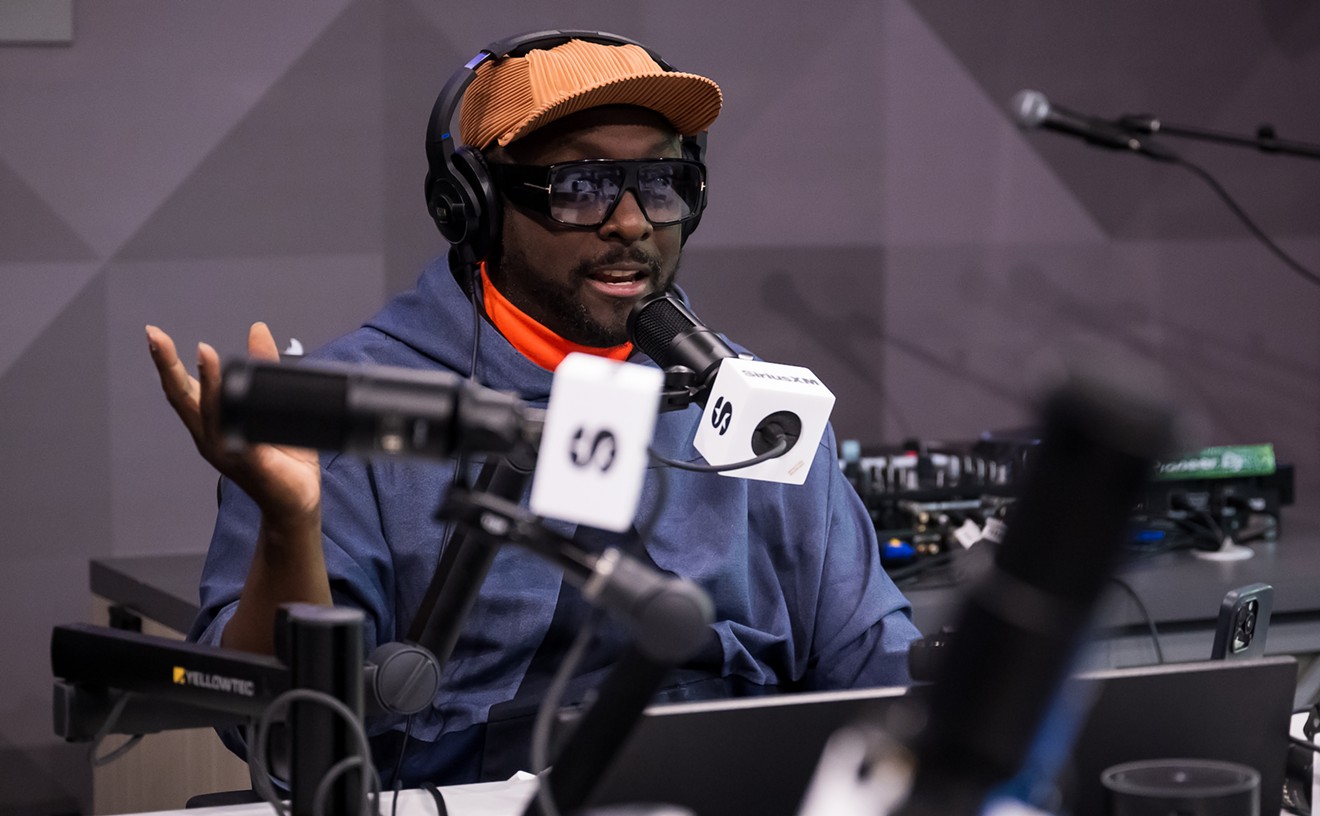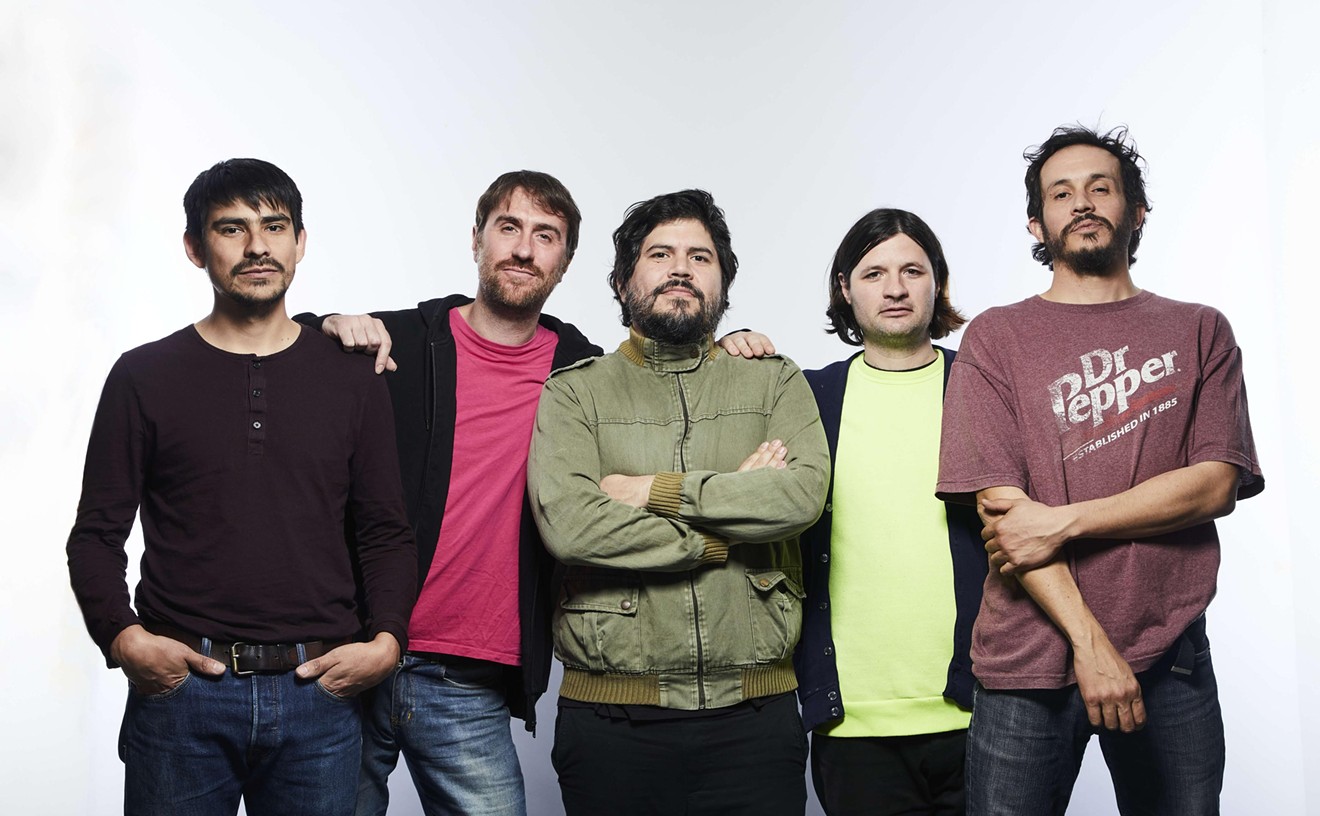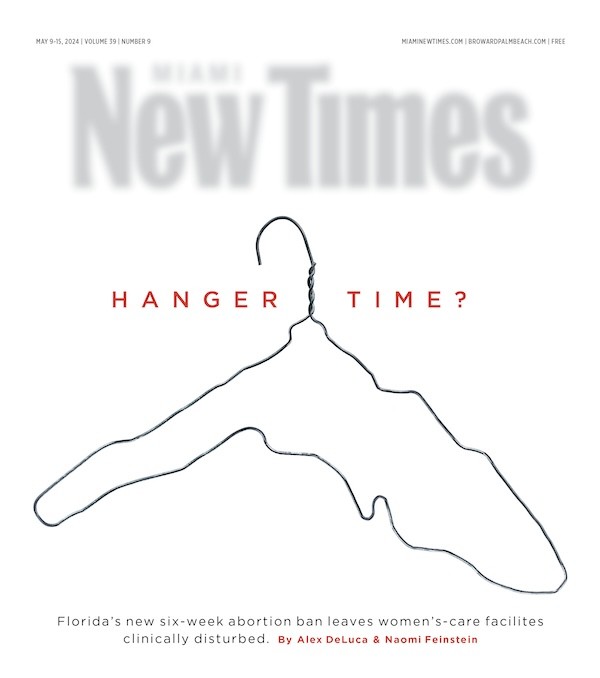At stage right stood Beto Cuevas, the Ziggy Stardust look-alike, Big Eighties sound-alike lead singer of the Chilean trio La Ley, butched up at a back-up mike with a hood pulled over his tousled rust-color hair and rose-tinted shades. Half-stomping, half-slinking from stage left in a white sequined T-shirt and ivory brocade pants, Emmanuel Horvilleur of the insane Argentine funk posse Illya Kuryaki and the Valderramas wove a shimmery streak around Molotov's thrashing guitars and dual overdrive basses.
At the sonic epicenter of the show's climax, Gustavo Santaolalla, the 49-year-old producer and Latin alternative crusader, quaked before the mike. The mike stand shaking in his right hand and the gray hairs in his ponytail aquiver, Santaolalla seemed to channel all the energy of hip-hop and rock en español through his compact frame into a collective euphoria. “C' mon everybody,” screamed Molotov rapero and bass player Mickey Huidobro over the veteran producer's shoulder. “Let me hear you say puto!”
“Puto” is an anthem for hip-hop rockeros who would be more likely to shout down Ricky Martin than sing along with his “Livin' La Vida Loca.” Literally “male prostitute,” puto can mean “womanizer,” “fag,” or “wimp,” depending on where you are and what mood you're in. In a public-relations moment, Molotovians will swear they're down on wimps and have nothing against gays. Whatever their target, crying puto is just the kind of bad behavior that gets Molotov into trouble with feminists, gay activists, the Mexican government, and the Catholic Church -- and that has helped them sell more than a million copies of their naughty 1998 debut disc Donde Jugarán Las Niñas? (Where Will the Little Girls Play?) and the followup Apocalypshit worldwide.
Molotov headlines Watcha Tour 2000, a late-summer, eighteen-city trek across the United States, Puerto Rico, and the Dominican Republic by a shifting roster of bands thrown together mainly because of what they are not: They do not sing in English and they do not play Spanish-language radio's favorite Mexican and tropical pop. Add to Molotov's trash-talk the socially conscious fury of Argentine hardcore A.N.I.M.A.L., the experimental eclecticism of the Mexican foursome Café Tacuba, the tripped-out folklore of the Colombian Aterciopelados (The Velvets), and the soothing balladry of Argentine pop mainstays Enanitos Verdes. Introducing U.S. Latinos and adventurous non-Latino youth to the edge of Latin music, the Watcha Tour is part of a crossover formula set up to let Latin boyz be boyz and Latin girls be singer-songwriters.
Molotov's U.S.-born drummer, 23-year-old Randy “El Gringo Loco” Ebright, could be a poster child for the Latin alternative cause. Rather than wait for the music to cross over, the blond-haired Anglophone crossed the Mexican border with his engineer father, got mixed up with Molotov's band of noisemakers, and played rap-core in Spanish long after his father had finished his assignment and gone home.
For his part the young expatriate believes the record industry's search for Latin alternative gold might be as elusive as the conquistadors' quest for El Dorado, and he likes it like that. Sipping a beer in the dressing room after the show, Ebright explains that the obstacles to commercial success in Latin America “keep the rock scene a lot fresher. Here it seems like it's all one big Nike commercial.”
With Latin alternative discs selling like stale tortillas, the industry seems safe from stultifying success. The LAMC organizers, promoter Josh Norek and artist-manager Tomas Cookman, hope to change all that. The LAMC goal, they say, is “to help make the market grow for Latin rock and hip-hop.” It's no mistake that the event took place far from Miami, our self-styled capital of Latin music. Making the market grow for the LAMC means wrenching the music out of the Latin category and making it music for the (English-speaking) world.
More than 700 producers, label execs, promoters, music writers, photographers, dot-com bilinguals, border superstars, and unsigned wannabes showed up at the LAMC to swap business cards, trade CDs, and shore up one another's morale. In between parties and music showcases, two days of panel discussions highlighted the challenges to breaking Latin alternative into the global pop market.
Latin rock and hip-hop reach a large audience throughout Latin America, especially in Mexico, Argentina, and Colombia. The regional economy leaves consumers without the cash to snap up mass quantities of CDs, however, leading the LAMC to focus on the lucrative U.S. market, full of music-hungry teens flush with dollars. Turning those teens into fans can be hard, since Latin alternative music is rarely heard on Spanish-language radio, locked up by tried-and-true programs of salsa, merengue, Mexican regional, and innocuous pop, and not heard at all on English-language rock and hip-hop stations. Spanish-language video music programs, such as the Miami-based MTV-S and H-TV, do feature alternative music, but U.S. audiences can only access these stations via satellite. English-language video programs such as MTV and VH1 stay away.
Mainstream English-language magazines and newspapers have been friendlier. In fact music editors assembled at LAMC claim they have had to beg for material from the Latin divisions of the major record labels, most of which are located here. Jon Dolan, reviews editor of mainstream-music powerhouse Spin, said he rarely receives Latin recordings in time to get reviews out. Mike Shea, of the important national music magazine Alternative Press, admitted he has a hard time getting Latin material at all. “One time I received a plain brown paper package from WEA-Latina,” he recounted, “but nothing else. I was happy to get it; I just didn't know what it was.” Intrigued on another occasion by titles released on Sony Discos, he said the division's hard-to-get reputation led English-language colleagues to tell him: “Don't even bother.”
Over and over again participants complained that the major labels staff Latin divisions with people who know how to sell salsa and merengue but have no expertise in promoting hip-hop or rock. Miami is so closely associated with tropical Latin sounds that the most important Spanish-language alternative magazine in the United States, La Banda Elastica, pointedly has contributing editors in Los Angeles, New York, Argentina, Mexico, Puerto Rico, Spain, Texas, and Chicago -- but not in the Magic City. Miami's own Spanish-language magazine, Boom, run by tireless Latin alternative booster Kike Posada, had a booth at the conference hall but was not invited to participate on the print media panel.
“I'm grateful to all the radio stations in the United States that don't play our music, because it makes us stronger,” joked Gustavo Santaolalla, founder of the influential Seventies Argentine rock outfit Arco Iris and currently one of the most powerful producers of Latin alternative music. Head of Surco, the new alternative label distributed by Universal, Santaolalla is behind success stories such as Molotov and Café Tacuba, as well as the Puerto Rican rockers Puya and the Afro-Cuban hip-hop crew Orisha. For him the coming of Latin alternative is a social phenomenon and not a record-company invention. “The context of alternative music in Latin America is very strong,” said Santaolalla, with less frenzy but just as much passion as he would show onstage with Molotov later that night. “You feel it from the day you are born,” he explained. “What you are struggling against has a face and a name. That gives the music an energy, a voltage, that's very strong.”
Camilo Lara, the general director of Virgin Records Mexico, claimed that the problem in selling Latin alternative is not lack of energy but lack of funds for production. “We want to be competitive in the Anglo world,” he said, “but we do not have budgets that are competitive -- at least not in my country. When I go to the store, I don't go to the Latin section. I go to buy either Marilyn Manson or Molotov. If I have only $15 or $16, I have to buy the best record.” Santaolalla agreed, “Great records, most of the time, require big investments of money. That's one of the things that we pushed as producers: to make expensive records for a kind of music that is usually done cheaply. To make records that don't have anything to envy from the Red Hot Chili Peppers or Jane's Addiction.”
Latin-American youth have long listened to music in English made by their North American and European peers. Turning that relationship around might mean changing little more than the language. “Growing up in Latin America, you don't necessarily just listen to Latin music,” pointed out Andres Levin, the Venezuelan-born producer of Aterciopelados and of his disco-fueled compatriots, Los Amigos Invisibles. “It's completely acceptable that a band be completely drum and bass and be from Nicaragua.” Depending on the band, singing in English might even be organic, added Santaolalla. “I don't push the band to do anything other than what they're already doing,” he said. “For a band like Molotov, who has a drummer from the United States or with Puya, from Puerto Rico, it makes sense to sing in English and in Spanish.”
If Latin artists and producers are thinking in terms of social movements, industry execs think in trends, viewing the Latin alternative boom-to-be in terms of the slow growth of alternative rock in English that finally exploded with the success of Nirvana in the early Nineties. “It's like 1984,” observed Brian Long, director of A&R for MCA. “It's going to take an artist who's Latin, who is going to sing in Spanish” to make it really big and set off a signing frenzy among the major labels. Kim Buie, senior executive at Palm Pictures, who recently signed border electronicistas Nortec and previously hooked up happiness-meisters Plastilina Mosh with Capitol Records, said the LAMC reminded her of the 1982 new-music seminars that gave a boost to early altrockers such as R.E.M. and Sonic Youth.
Camilo Lara lived a different history. “It's like Mexico in 1990 or 1988,” he said, when there were few rock en español venues and major bands like Maldita Vecindad and Café Tacuba had not yet reached mass audiences. “We just need to have this one great band to happen,” Lara added reassuringly, “and things will change.” Brian Long sees the one-great-band theory as fraught with danger. “After there's a major success, all the major labels will promise the world,” he warned. “Ninety-nine percent of that time the world will not happen. You probably won't even get America.”
Perched on overstuffed couches and leaning against the wood-paneled walls in the intimate nightclub Nell's, the crowd sat spellbound at the LAMC “s Acoustic Writers-in-the-Round Showcase. Singer Andrea Echeverri, of the Colombian alt-fusion group Aterciopelados, swayed atop the tiny stage, the orange-stacked high-tops at the end of her long legs knocking against her stool. Founding bandmate Hector Buitrago played guitar, diminutive beside her. The ups and downs of Aterciopelados' career gives an idea of what an international boom -- and bust -- might mean for Latin alternative bands.
Opening with the not-yet-released song, “Uno Lo Mio y Lo Tuyo” (“I Unite What's Mine and What's Yours”), Buitrago picked out a stripped-down version of the vallenato on the guitar, suggesting the popular Colombian rhythm with nothing but a steady suspended pulse. Echeverri sang, “Fluyo/me escabullo/huyo de este barullo/fluyo/me zambullo/en arrullos/me diluyo” (“I flow/I slip away/I flee from this confusion/I flow/I plunge/in murmurs/I dissolve”). The song could be a gentle anthem for a band that has ventured onto the global market only to retreat, at least for the moment, home. On a phone interview from Bogotá before the conference, Echeverri said of the song: “It's abstract but it's a way of asking people to think of what they can do together. Of what they can do for Colombia.”
Next the couple runs through the account of their own romantic breakup years ago, recorded in “Bolero Falaz.” Echeverri's eyes screwed shut and her mouth opened wide as she sang of “more days of hatred and melancholy.” This “Fallacious Love Song” on 1995's El Dorado introduced Aterciopelados, already popular in their native country, to ears across Latin America. Their subsequent two discs were recorded in London and New York City, by the British Richard Blair and Venezuelan Andres Levin. The alt-folk-rockers have come full circle from El Dorado, producing their current project themselves entirely in Bogotá, even doing the preproduction in Buitrago's house. The recent closing of their record label, BMG-Colombia, left them to their own devices. Making a virtue of necessity, the pair rallied friends and took several months to produce the still-unnamed disc according to their own specifications and with all Colombian musicians.
“Let's say that we had to pass through this process of going to the studios of the great producers out of curiosity,” said Buitrago. “We decided for this disc to have a very particular sound. On the other project, there were details missing, and that's what the producer put in, deciding what goes where. This time we knew really well what we wanted. And we decided that we were the best ones to achieve what we wanted.” Adds Echeverri: “We made it with a lot less money, but we made it here. This one is more rooted in Colombia, according to Hector's criteria. It's very truthful. There's a lot of honesty.”
There also was a lot of homegrown talent, sampling widely from Colombia's diverse musical traditions and adding folkloric flavor to the trip-hop vibes the group picked up from Levin. A bass player from the coast brought in an Afro-Colombian percussion instrument and set the whole band to dancing. A woman who played an Andean flute took several days to “interiorize” the music before she could perform. “In New York it's all session musicians,” said Buitrago in contrast. “Even though they're incredible musicians, you miss out on details.”
Global sound infused with local sentiment is typical not only of Aterciopelados but of many successful Latin alternative acts. “There's not really a genre,” said Echeverri. “It's like “the music of Aterciopelados,'” observed the singer. “Unlike some other rock groups, we don't reject the music of our parents. We let everything flow,” added Buitrago. “You take the [national and transnational] elements and you develop your own language.”
That language comes in part from the Latin-American context Santaolalla described. “There have been difficult moments for Colombia for as long as I remember,” observed the guitarist-cum-producer. “Lots of artists are trying to get out of the country. We feel like we belong here in a certain way, that they need us here. All day we're filled up with bad news. Music becomes a refuge.” The singer agreed: “Here we're important and there's a lot of press, so that people know what we do. They see that a person who has the possibility of going is staying. They see that we're here in the thick of the fight.”
Ironically Aterciopelado's international success heightens the band's importance at home. “There have been a number of magical moments for us,” Buitrago remembers. “The days after we were nominated for the Grammy [in 1998], we were coming back from New York. It was incredible. The people stopped their cars and shouted, “Bravo. Do it! Let's win it for Colombia!' After playing a lot of dates outside, you forget how much affection people feel just having you there. Then when the group is about to leave, there's kind of an energy loss. It makes your hair stand on end.”
Finishing with the cumbia-inflected “El Estuche” (“The Carrying Case”), from the 1998 Caribe Atomico, that warns listeners to “look at the essence, not the appearance,” Aterciopelados wove through the close-set tables at Nell's and the cramped knees of photographers sitting on the floor. The three young men from La Ley took up their instruments, three Chilean men adding to the night's national mix of Argentines, Mexicans, and Colombians -- a mix typical of Latin alternative shows.
Speaking from Buenos Aires on the upcoming Watcha Tour, Marciano Cantero, of the earnest Argentine pop-rock trio Enanitos Verdes (Green Dwarfs) said that playing in the United States always presents “a mixture of nationalities. It's like Latin America is united in the United States. We're all part of one cultural place, with the same myths and the same sorrows.”
If the crossover dreams of the LAMC ever do come true, it will not be because Latin publicists in Miami learned the phone numbers of Anglo journalists in Cleveland. It will not even be because MTV starts playing Molotov. It will be because the nation's young rockers, hip-hoppers, and electronicistas -- Latino, Asian, African, and Anglo -- have finally learned that the United States shares the myths and sorrows of the Americas. And that we in the North are all part of the same cultural place, too.










